Laptop Mag Verdict
Immortals: Fenyx Rising is tons of fun thanks to engaging gameplay and a pleasant aesthetic, but it's narrative is dreadful and progression systems are too easily exploitable.
Pros
- +
Fluid combat system
- +
Excellent puzzles
- +
Pleasant aesthetic
- +
Solid exploration
Cons
- -
Mediocre writing
- -
Progression lacks balance
- -
Gets too easy
Why you can trust Laptop Mag
Immortals: Fenyx Rising boasts a vast open-world packed with satisfying secrets, a snappy combat system that successfully balances defensive and offensive tactics, and a generally pleasing aesthetic that is far more colorful than the average Ubisoft game.
Most of these elements aren’t exceptional, but they’re good enough to make Fenyx Rising worth playing. Unfortunately, the game stumbles with mediocre writing, a lack of balanced progression, and an unexciting rewards system.
Regardless, Fenyx Rising is a largely competent Breath of the Wild rival, and I most certainly enjoyed my 30 hours with it.
Mediocre writing
Fenyx Rising begins with Prometheus, the Titan god of fire, chained atop a snowy mountain peak when Zeus visits him for help. Typhon, a monstrous creature from the underworld, has escaped his prison and is wreaking havoc around the world. Prometheus suggests that Fenyx, the character we’ll be playing, is the one who will save everyone from Typhon’s volcanic destruction.
Here’s the issue: every character in Fenyx Rising functions on being intentionally obnoxious and this gimmick is rarely funny. Zeus is played off as an incoherent moron, and he frequently refers to how muscular and powerful he used to be. He’s essentially a brainless jock.
Prometheus is treated as a sensitive artist who wants to tell his story with as many sophisticated buzzwords as possible. Zeus frequently sighs and complains when communicating with him because, of course, he has a poor understanding of language. Many of the jokes between them devolve into Zeus looking like an idiot, protesting against Prometheus’ “cleverness.” This wouldn’t be as offensive if Zeus and Prometheus only interacted during cutscenes, but both are narrating every moment of your journey.
Hermes is simultaneously cocky and cowardly, and throughout every scene he’s concerned only about himself. It’s annoying because Hermes will teleport into a scene and provide his input. Everytime he does, I sigh with great contempt. Typhon is hard to take seriously, too. Not only does his design look like something straight out of a cartoony Diablo game, but his personality is basic. He frequently speaks to the player, and when he does, all he says is some form of “I’m gonna get you!”
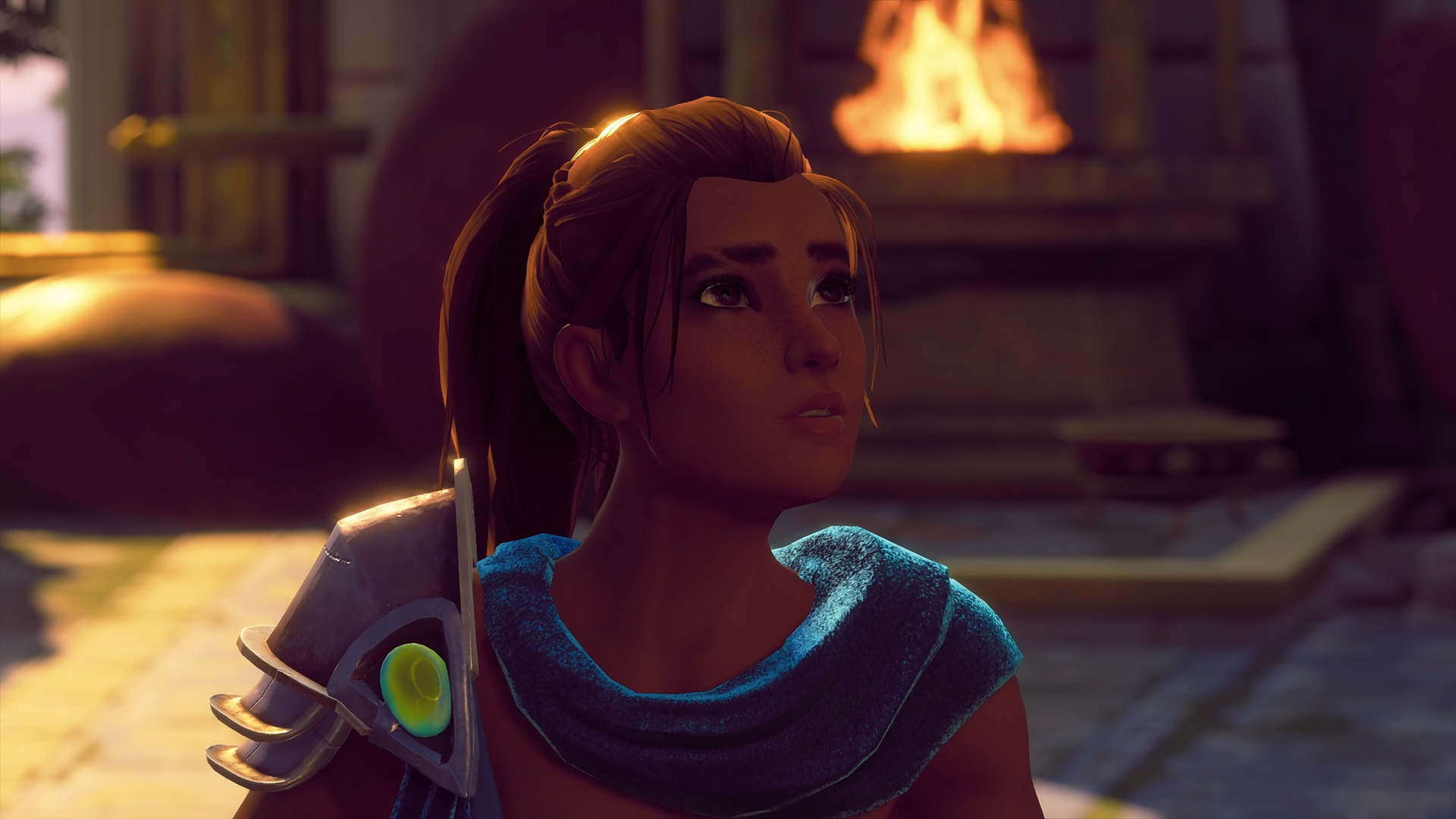
Fenyx is one of the less annoying characters, as they actually have a sympathetic arc later on in the game. However, they’re still overconfident and their entire personality revolves around saving people. There’s one moment where they try to help Hermes, and while looking down at him being surrounded and nearly devoured by monsters, Fenyx decides to flex their muscles to look cool.
However, I actually quite liked all four Gods the player has to save throughout the game. Ares, Athena, Aphrodite and Hephaestus have been cursed, and how they’re portrayed is quite amusing. Aphrodite has been turned into a nature-loving tree with a wholesome passion for wildlife. This is especially funny when similar games like God of War portray her as an incredibly lustful character. Additionally, Athena has been turned into a child, making her wisdom and strength pretty much inaccessible.

Certain elements of the narrative did get exhausting, though. Throughout Aphrodite’s quest, we essentially have to bring her vanity back to her. The game treats this as if it’s an important part of her essence, and it’s annoying that the player is encouraged to simply “accept” her judgemental, envious and selfish personality. The game makes it pretty clear that these quirks have resulted in so much pain and suffering around the world, yet her emotional stability is seemingly our priority. I get that we’re trying to save the world, but it’s weird how our primary goal was to bring these selfish and destructive gods back into power.
Satisfying combat
Fenyx Rising’s combat is engaging. There’s a decent bit to work with here, allowing for most fights to be flexible, as the player can dodge, parry, throw objects, shoot arrows, use special abilities, and attack with a sword or axe.
Some battles require crowd control with an axe, swinging at multiple enemies to deal lots of damage. Other battles require constant dodging and parrying to ensure you can evade devastating damage. And sometimes, you can pick up rocks and toss them at a giant cyclops.
I felt compelled by this gameplay loop, as I’m a sucker for any game that encourages defensive play-styles involving parrying and evading against challenging enemies. I played on the Hard difficulty, and initially enjoyed how nearly every foe could kill me in two or three hits. It forced me to play carefully and added much-needed intensity to most encounters. However, this quickly stopped working, as the game’s progression systems are far too easy to exploit.
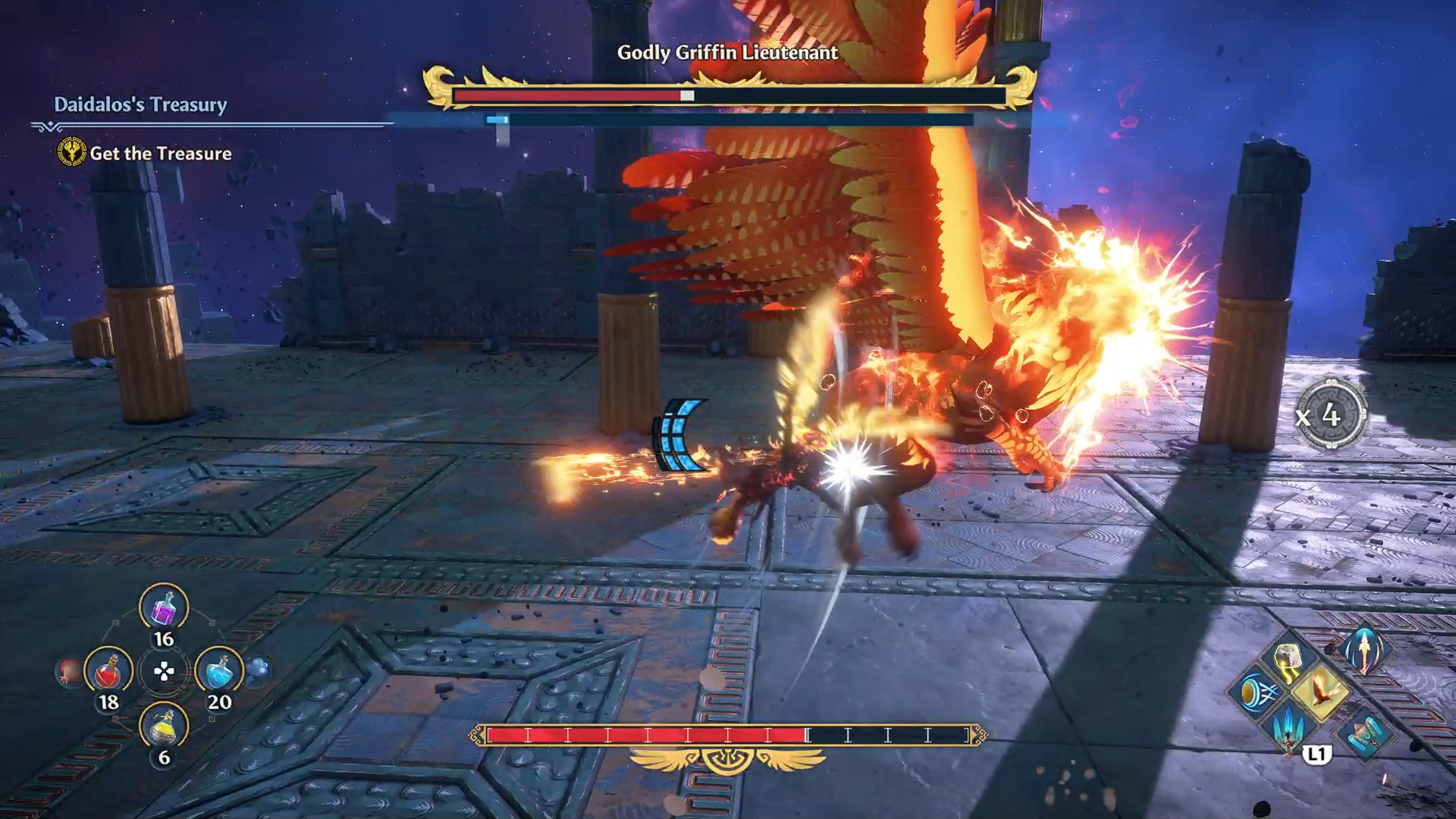
Players also have access to special abilities later in the game; you can summon giant spikes up from the ground, charge at the enemy with a spear attack, and slam a gigantic hammer into a wave of enemies to deal ridiculous amounts of damage.
However, parrying rarely felt useful. Dodging at the perfect time seemed like the better alternative as it freezes every enemy in the vicinity. Even if the player misses the perfect dodge timing, they can evade the range of the attack.
Many enemy attacks are unparryable, and even when the player does parry to fill up an enemy’s posture bar, it only temporarily stuns them. While the enemy is stunned, the player can attack them freely, but this doesn't feel like a practical risk to take due to how little damage is dealt. Instead, you could just as easily create the same effect by attacking with your axe. The parry mechanic is high risk, no reward.
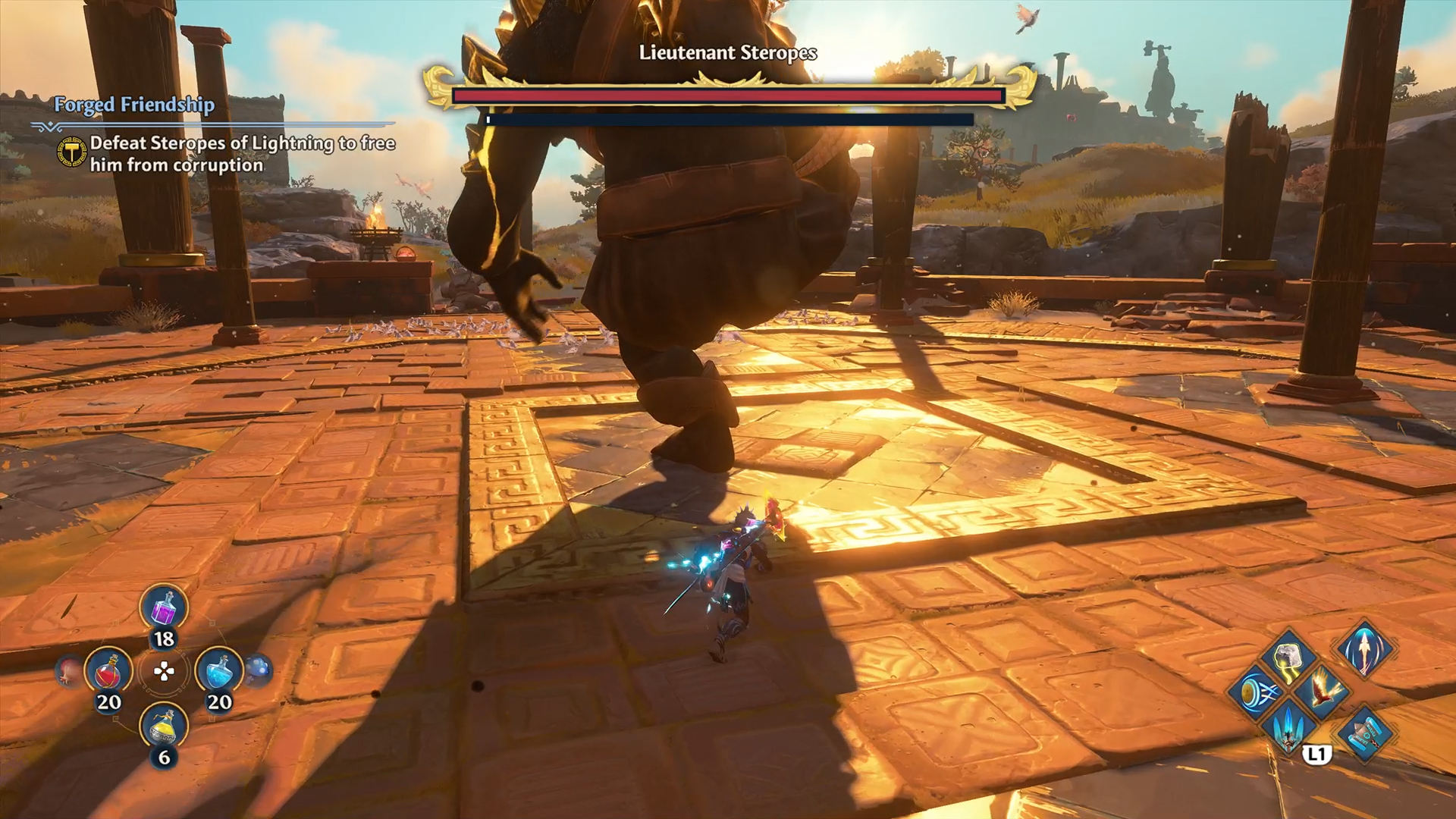
Players can also damage enemy posture bars by throwing objects at them, which not only does tons of damage, but is a more satisfying and effective alternative to parrying.
This isn’t to say parrying was always a less successful alternative to dodging. Throughout many different battles, like the one with Lieutenant Aello, parrying ranged projectiles deflected them back toward the enemy, dealing massive damage. This was the only time I found it to be useful, though.
Solid exploration, unexciting rewards system
The Legend of Zelda: Breath of the Wild’s formula is undeniably effective, and even though Fenyx Rising doesn’t come close to its level of mystery and intrigue, it still does a solid job at presenting a world jam-packed with secret fights, puzzles and unique locations.
The puzzles are quite creative in how they utilize the game’s mechanics to present players with obstacles. It rarely feels like there’s a mystery that needs solving, as the mechanics are quite clear. Instead, the game is asking the player to successfully utilize the systems at play to overcome what lies ahead.
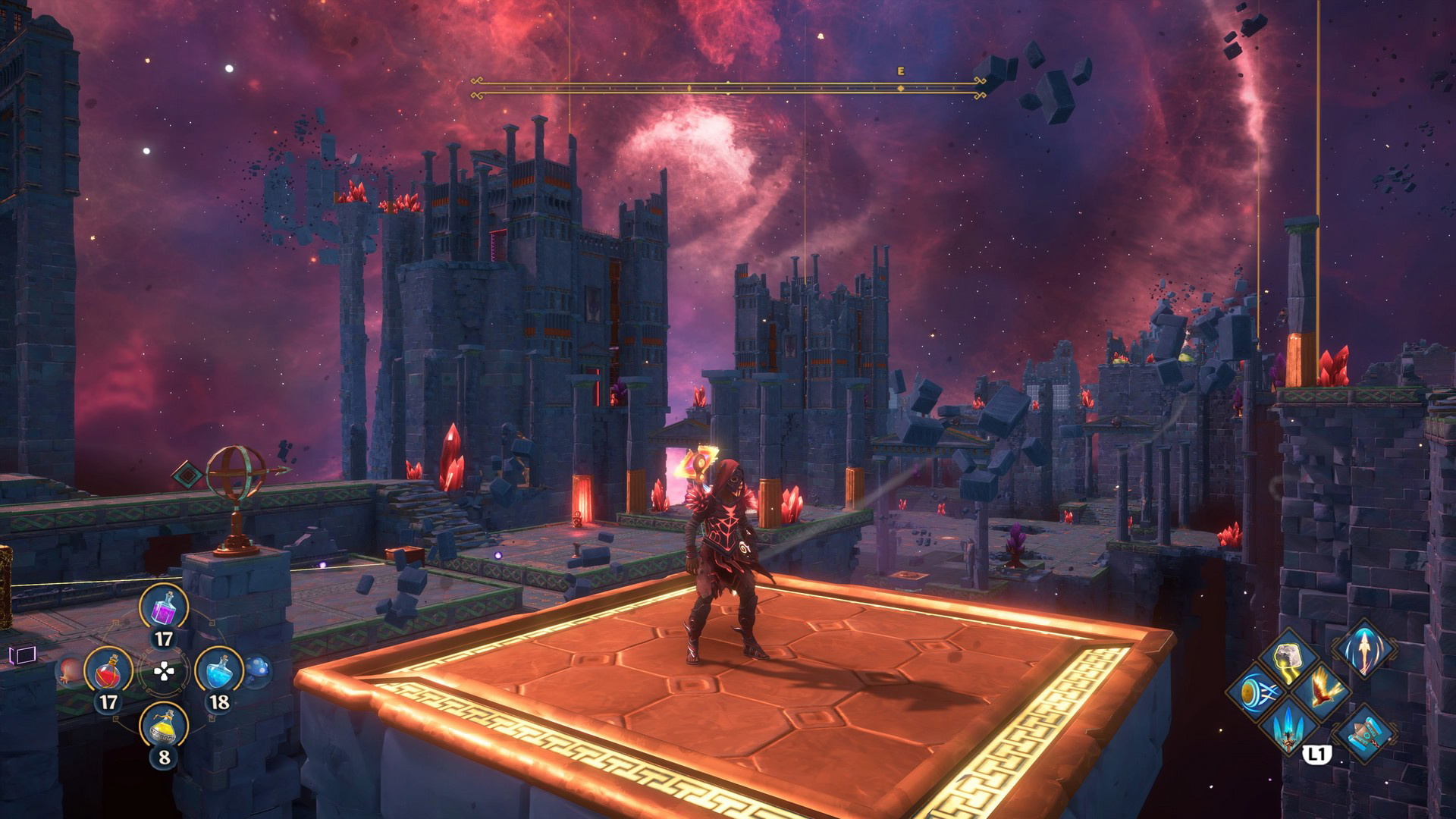
For example, one puzzle required me to shoot large metal balls through box-walls to land them on a button to activate the path forward. One involved pressing pressure plates in the correct order while fireballs launched across the arena. And another forced me to carefully stack boxes atop each other to glide across large gaps. Each puzzle was different from the last, giving me enough incentive to complete every Vault of Tartaros (the name of the puzzle rooms).
Additionally, the game rarely let me down when I checked the hidden corners of the world or tried to climb atop tall structures. There are tons of secrets everywhere, but unfortunately, the world is mostly occupied by upgrade materials. The issue is that every unlockable is immediately presented to the player in the Hall of the Gods. (Here, you can unlock and upgrade new abilities as well as enhance your armor, weapons, stamina, health and potions).
Instead of the player reaping these exciting rewards within the world naturally, like through a secret trial with a challenging obstacle, players only need to find the necessary currency scattered across the world to unlock those abilities. This is still a fine progression system, as the game provides an incentive to explore with worthwhile rewards, but it’s not very immersive or exciting.
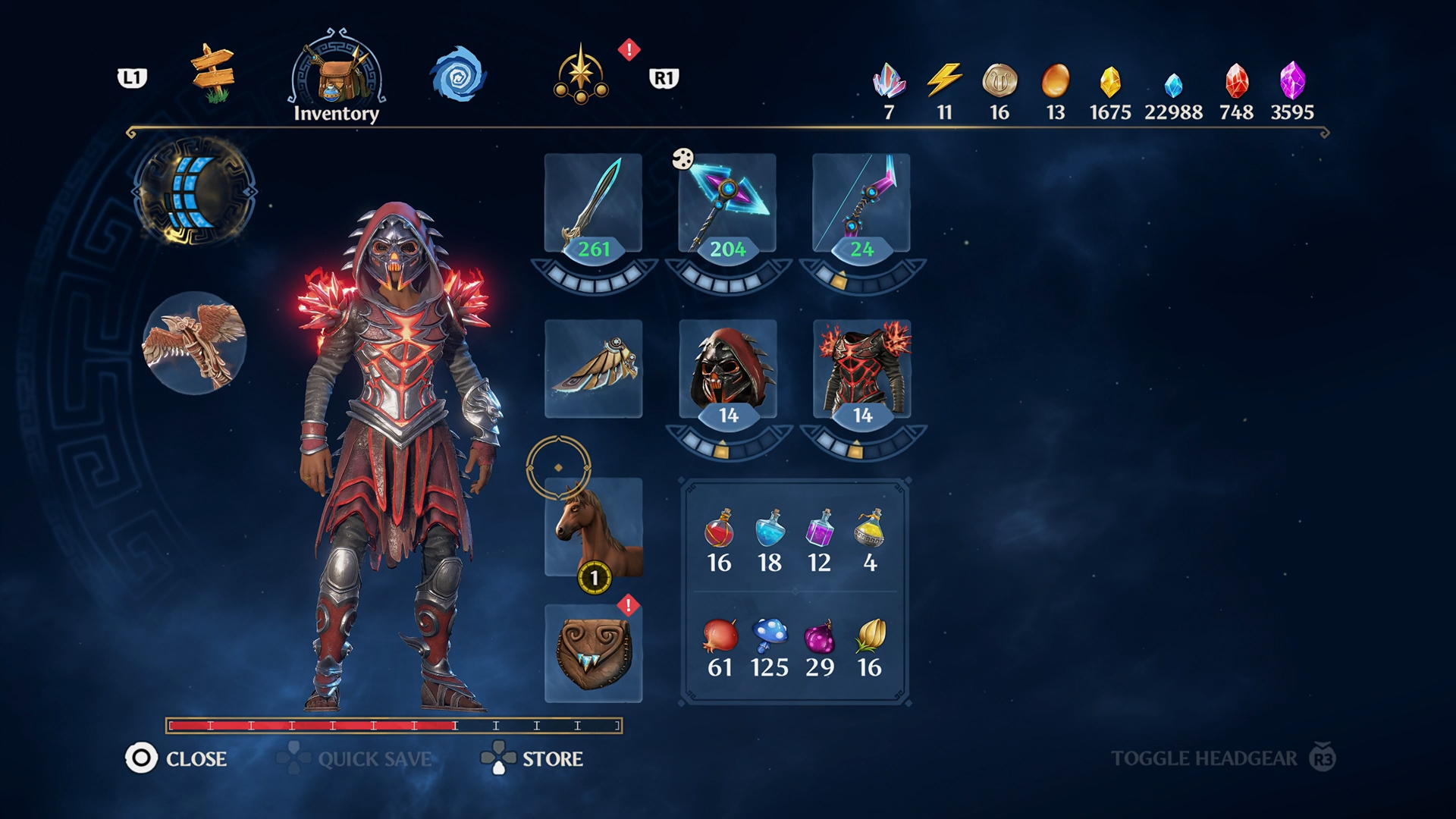
Another issue is that every upgrade is exponential. For example, if you focus exclusively on upgrading your sword (which is what I did), every new upgrade is double the strength of the last for a not-so drastic price. If you were to balance your damage and armor upgrades equally, you’d probably be stuck in a middling damage tier, but if you go hard into one upgrade, you could be dealing three times the damage you would have otherwise. I focused exclusively on upgrading my sword, which meant I was doing around 250 damage per hit. My axe, on the other hand, was only doing 20 damage.
This meant every fight I found myself in became trivial. Legendary encounters were all easy and required little to no thought, especially when using a damage upgrade potion. One of the final battles took me less than thirty seconds to defeat, and keep in mind, I was playing on Hard.
Additionally, the discoverable weapons merely change the player's statistics rather than their moveset. You’ll always be slashing your sword and swinging your axe with the same animations regardless of how many new weapons you collect. And to make matters worse, many armor rewards are merely cosmetic alternatives to previous ones you’ve already found.
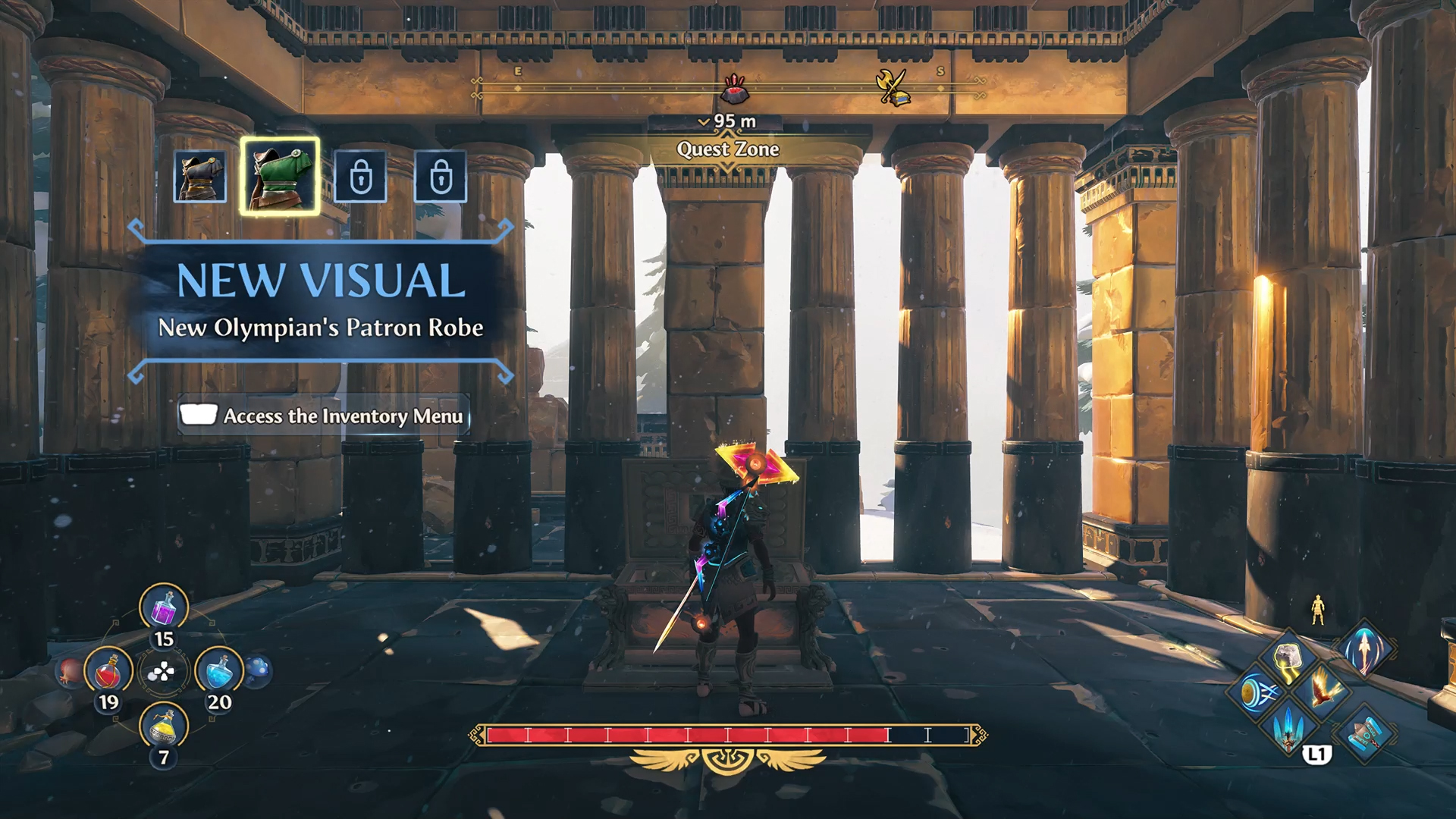
I went on a large-scaled quest from Hephaestus to make a super powerful armor set, and when I got to the Forge of the Gods, I crafted this equipment piece to realize that it was merely a cosmetic variation of an armor piece I had. This epic quest should have been met with an equally epic reward.
Pleasant aesthetic
Fenyx Rising presents a more fantastical world than we typically see in the average Ubisoft game. It’s full of humorous designs, colorful environments, and looks less realistic or grim than something like The Division, Far Cry or Ghost Recon.
The game's environments are pleasant, as the foliage, trees and water look like a soft-brushed painting. I also enjoy the color schemes; the game’s second area blends pink and green trees against sandy beaches and marble temples to create a cartoony reflection of ancient Greek architecture. The Tartaros Rift is also nice, as shattered stone platforms floating around a dark purple fog with bright white stars dotted across the sky creates a delightful cosmic visual. I was also a big fan of King’s Peak, as the sheets of snow overwhelming every path and cliff-face was a sight to behold both in terms of scale and beauty. The feeling of slowly ascending through streaks of an aurora borealis with lightning striking against the peak of this colossal mountain was undeniably exciting.
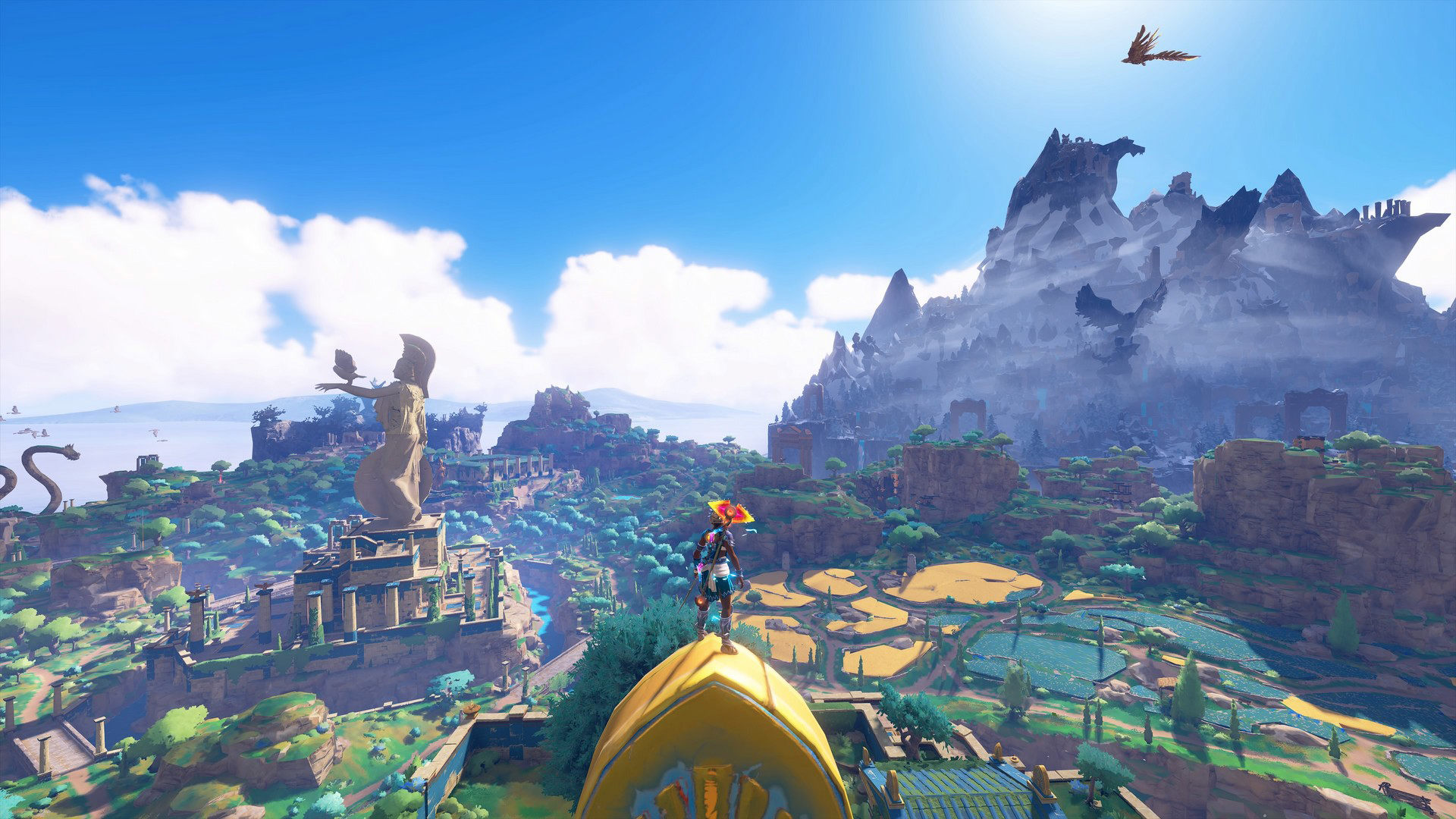
While the world looks pretty, the character designs are ugly (standard for a Ubisoft game). The base playable character, in particular, looks awkward, and although I managed to clean them up, they still looked strange in cutscenes.
Enemy designs are generic, with giant cyclops, mythical Greek soldiers and gorgons lacking distinct traits. However, I was quite impressed that there’s a good amount of enemy variety. You’ll be fighting three headed dogs, robot creatures, griffins and minotaurs. However, don’t expect every new big fight to truly be a new boss type, as there are a handful of reused griffin and cerberus boss encounters throughout the game.
Immortals: Fenyx Rising PC performance
Immortals: Fenyx RIsing was a surprisingly bug-free experience for me, which is mostly shocking due to Ubisoft’s track record. I haven’t experienced a single crash or bug that hindered my progress throughout my playthrough. This might be thanks to the game’s delay from February 26 to December 3, as those extra months must’ve helped to polish the game.
Similar to many other Ubisoft games, Immortals: Fenyx Rising allows the player to completely customize their HUD. This is useful for those who want to increase the game’s immersion. You can turn off quest objectives, celebrations, loot, compass, message panel, critical message, hero health, hero stamina, abilities, potions, damage numbers, combo meters, target lock-on, enemy health, incoming attack warning, detection feedback, aiming reticles, stealth indicator, occlusion silhouettes, interaction module and contextual actions.
Some of these are pretty vital, but others are a bit more expendable, like damage numbers and combo meters. Additionally, the menu can be completely narrated if you prefer, and you can even change the speed that it reads and whether its voice is either feminine or masculine.
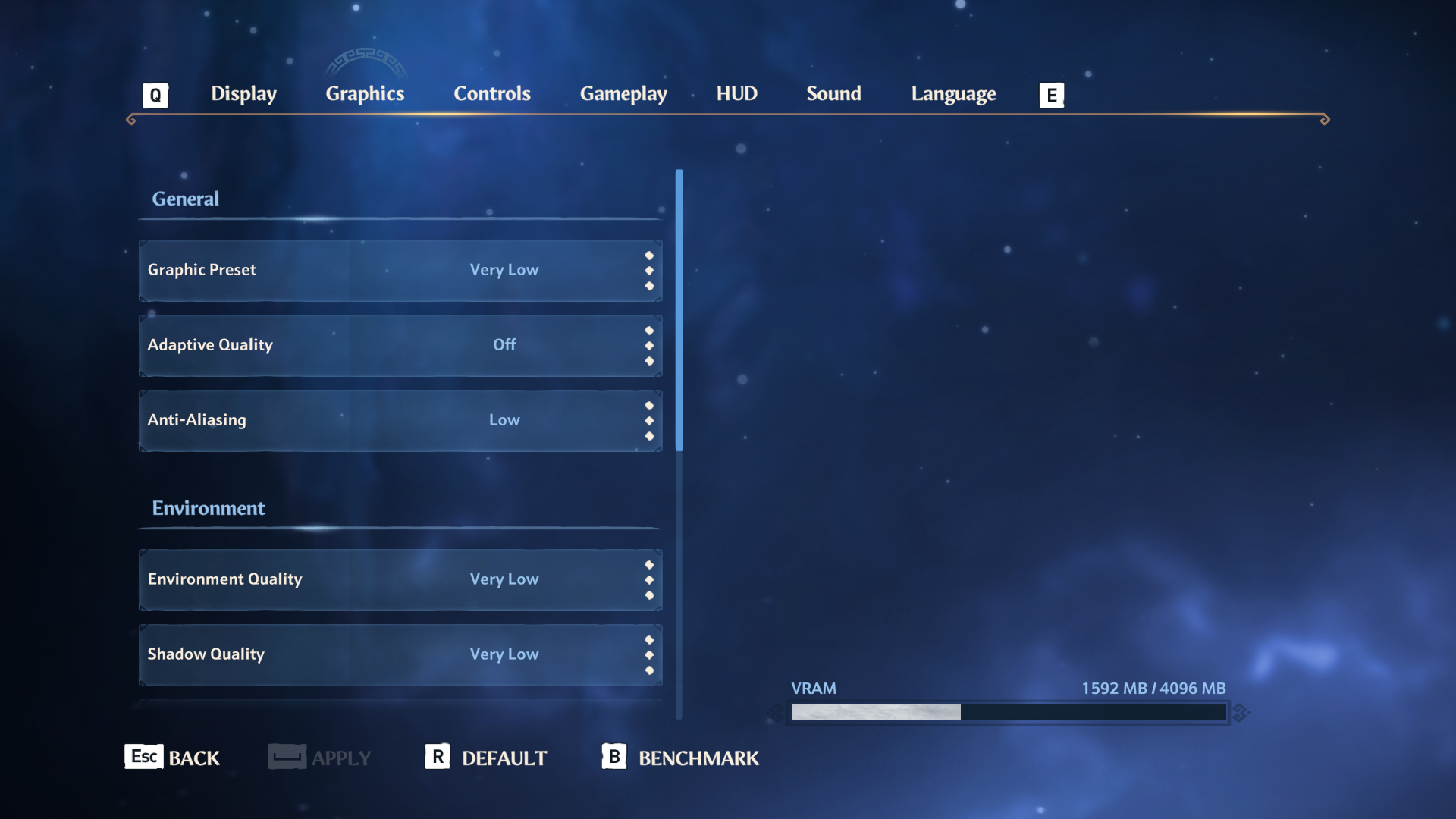
You can tinker with a few settings in Immortals: Fenyx Rising, such as overall quality settings, anti-aliasing, environment quality, shadow quality, effects quality and texture quality. Adaptive Quality can be changed between 30 fps, 45 fps and 60 fps. You can also turn depth of field, motion blur, ambient occlusion and screen space reflections on or off. VSync can be turned on, off or set to Adaptive. There’s also a resolution slider which can go between 50% to 200%. And you can change window mode to borderless, fullscreen and windowed.
Fenyx Rising also has colorblind settings, allowing the user to switch between red, green and blue enhanced filters. You can also adjust the filter intensity from 0% to 100%.
Immortals: Fenyx Rising PC benchmarks and requirements
I tested Immortals: Fenyx Rising on my desktop, which is equipped with an Nvidia GeForce GTX 970 GPU with 4GB of VRAM and an Intel Core i7-6700K CPU. At Ultra settings with 1080p resolution, I ran a benchmark and got an average of 20 frames per second. I also got 31 fps on Very High, 34 fps on High, 45 fps on Medium, 50 fps on Low and 57 fps on Very Low.
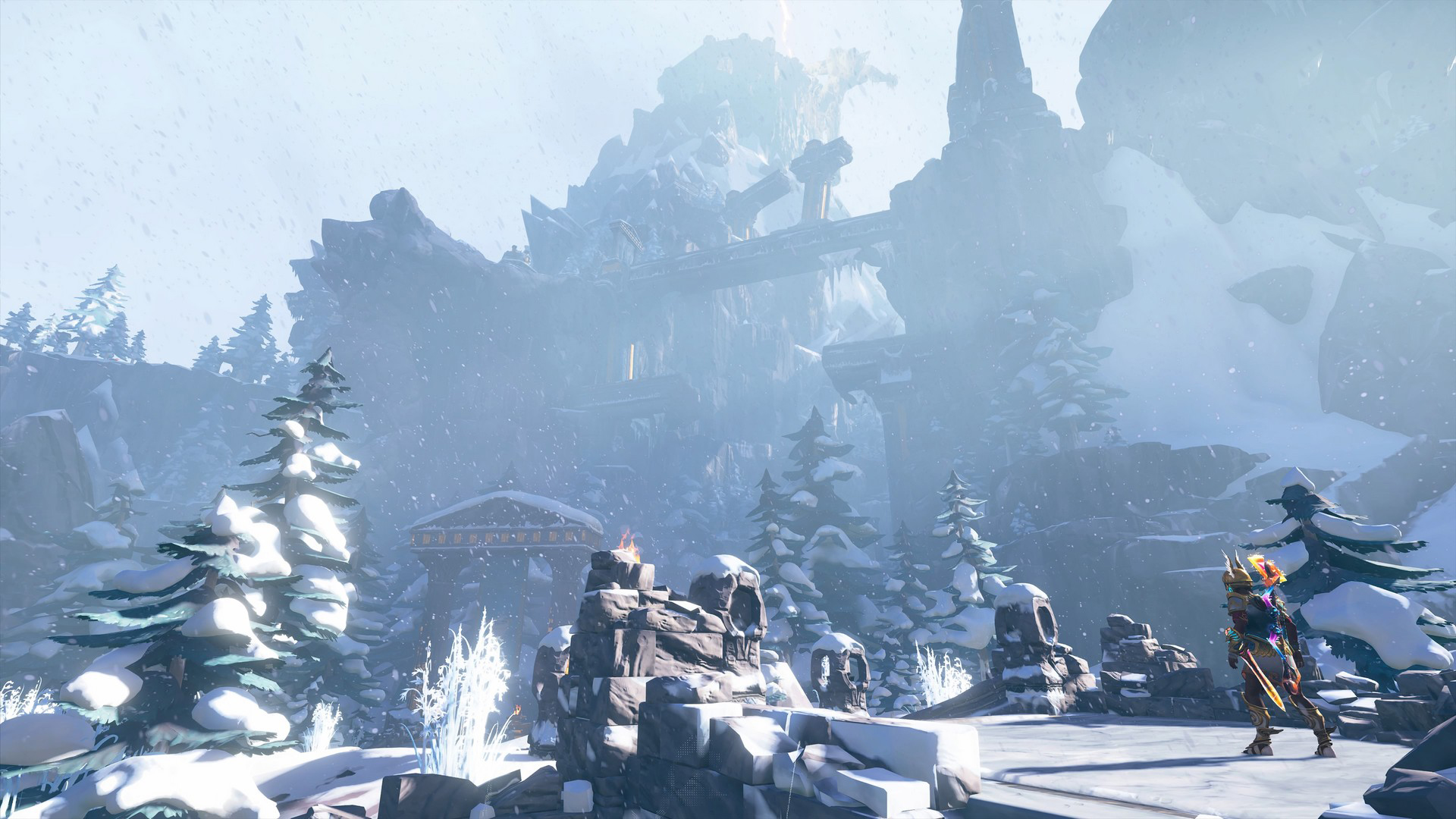
The minimum requirements to run Immortals: Fenyx Rising includes Windows 7, a Intel Core i5-2400 or AMD FX-6300 CPU, Nvidia GeForce GTX 660 or AMD Radeon R9 280X GPU, 8GB of RAM and 28GB of storage space.
The recommended requirements to run Immortals: Fenyx Rising includes Windows 10, Intel Core i7-6700 or Ryzen 7 1700 CPU, Nvidia GeForce GTX 1070 or AMD Radeon RX Vega 56 GPU, 16GB of RAM and 28GB of storage space.
Bottom line
If you’re a fan of The Legend of Zelda: Breath of the Wild, you’ll likely enjoy what Fenyx Rising has to offer. I went into this experience expecting mediocrity, but was pleasantly satisfied by an addicting open-world RPG experience with tons of awesome puzzles, fun combat encounters and a visually pleasant world.
However, it stumbles quite a bit, most notably regarding its mediocre script, unbalanced (and easily exploitable) progression systems and a far too trivial end-game, even when playing on hard mode.
Regardless, Fenyx Rising is one of the most surprising games of the year, and although it’s not great, it’s undeniably tons of fun.

Self-described art critic and unabashedly pretentious, Claire finds joy in impassioned ramblings about her closeness to video games. She has a bachelor’s degree in Journalism & Media Studies from Brooklyn College and five years of experience in entertainment journalism. Claire is a stalwart defender of the importance found in subjectivity and spends most days overwhelmed with excitement for the past, present and future of gaming. When she isn't writing or playing Dark Souls, she can be found eating chicken fettuccine alfredo and watching anime.

